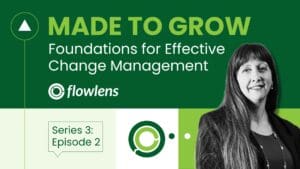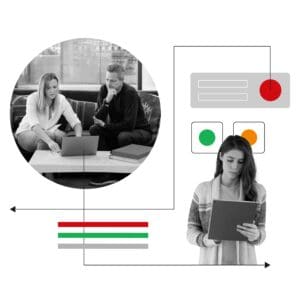So the search begins….
You’ll know when your manufacturing business is ready for CRM when you are:
- Spending too much time re-entering information over and over
- Chasing people for information at the last minute
- Losing out on enquiries or quotes that never got followed up
- Failing to track customer complaints and service issues, or not responding quick enough
- Not keeping on top of customer information and GDPR compliance
- Storing vital information in people’s head – if someone leaves they take the knowledge with them
Maybe you are the owner of the business, or perhaps you’ve been tasked with selecting the CRM. In either case you’ll be aware of the pains and challenges you are trying to solve for your business. Choosing a manufacturing CRM system involves identifying systems that solve as many of these challenges as possible. Remember, no software will meet your needs 100%, so be prepared to prioritise your ‘must have’ and ‘nice to have’ features.
Current pain points and objectives for CRM may include:
- Tackling inefficiencies
- Improving poor communication among your staff
- Integrating sales and operations for faster order processing
- Supporting strategic growth plans
- GDPR Compliance
- Monitoring and understanding sales activity
- Improving customer satisfaction
- Automating manual processes
- Getting reports and insights into your business performance
We’ll tackle all of these pain points in this article. So, what should you be looking for?
Mapping out your process
Before you begin your research, you need to understand your own process.
With your team, get a whiteboard or some post it notes, and write down the stages of your typical customer journey, from initial enquiry, qualification, quotes, nurturing, decision, order, and ongoing relationship touchpoints. Think about the information you capture (and in many cases duplicate) at each stage. Look for inefficiencies and bottlenecks.
No off-the-shelf system will handle 100% of your requirements or processes. Once you have a map on your process you can see how different CRM systems can handle your needs. Prioritise your requirements and score these against the systems you are evaluating.
Then, it’s important to think about what outputs and metrics your CRM should give you. What reports are essential for you to make decisions? Perhaps you want to track how many enquiries turn into closed deals, or forecast your sales for the year? Think about your “must have” metrics and ensure they’re easily available in any solution you consider.
Understand the Flavours of CRM software
There are many different types of CRM systems, designed to meet the needs of different businesses and circumstances. We’ve outlined 3 basic tiers below:
- Basic systems – these typically manage customer contacts, sales pipeline data and help you manage sales and customer service. These tend to be focused on sales and enquiry management, without much scope to expand into other areas of your business. Most “free” CRMs are in this bracket.
- Integrated CRM systems, also called “CRM+”- enable all of the above, but also allow you to add modules for other parts of your business, and integrate with your accounts: Quoting, Sales Orders, Inventory Management, Dispatch and Service Jobs are all common features of Integrated CRMs. Flowlens is an example of a “CRM+”
- Sector Specific CRMs – built around the needs of particularly sectors and processes, for example financial services, membership organisations, charities etc. and can have different names. CRMs used by charities can also be called “Electronic Case Management” systems, for example
Each of these has positives and negatives that are worth weighing up. And depending on the size of your business and your budget, you may find an integrated system meets your needs even though a sector specific system would be ideal, but out of your budget, for example.
Ask colleagues in your sector about the systems they use. Are they effective? Do they require minimal data entry? Do they handle the needs of your sector well?
Tackling Wasted Effort
As most businesses grow, processes spring up to address basic needs. Some aren’t even aware that a process exists.
Typically these consist of basic emails, spreadsheets, documents, bits of paper and verbal communication.
These work fine when you’re a small operation, but they soon crumble as demand grows for your products/services, and as you bring on more staff. What made sense for a small team will fail as you add more customers and more people to your business.
The simple process mapping exercise outlined above is a good way to benchmark your current system.
Perhaps you want to grow faster, and bring on more sales people, or increase revenues from existing customers. How do you know how to do this without reliable reports and an agreed system that handles your processes?
Inefficiencies take many forms, it could be:
- Rekeying of data between systems
- Losing information that is stored in people’s heads
- Losing paper
- Information stuck in emails that you can no longer find or access
- Unclear capture of customer requirements leading to poor handover between your sales and operations functions
- Limited or no ability to get reports from your information
- Errors in spreadsheets
- The list goes on
A good CRM will let you streamline these inefficiencies and should at minimum replace the vast majority of these pain points.
See how Flowlens customers increase sales and reduce waste in their processes.
Improving Communication
Confusion and misunderstandings are the most common cause of inefficiencies inside a business, and customer dissatisfaction. Many business have developed ‘silos’ around the main functions of sales, marketing, finance, operations and service.
This causes different teams to think inwardly, instead of collaboratively, which doesn’t serve the best needs of the customer.
A basic CRM will improve the communication of management and sales and enquiry teams while an integrated CRM allows the whole business to store data on a shared platform, for example.
Not only does this mean that you reduce the amount of rekeying of information, and potential for errors, you also get one ‘single version of the truth’ for your business. All customers, order, product and service information is in one place.
If you plan beyond the basics of capturing and storing customer data before choosing a CRM you might be able to see how systems can streamline your overall business process.
This will save your time and money in the long run, and make it easy to onboard new team members as your business grows.
Strategic Growth & Sales Tracking
You want to grow your business, but how can you develop your business plan without data?
CRM system can help you quantify your sales cycle, giving you valuable data to obtain funding/loans for your business, and justify spending money on sales and marketing.
If growth is a key concern you’ll want your CRM to include
- Tracking of inbound enquiries, sources and conversions
- Tracking of sales cycle
- Customer service / retention
- Customer repeat sales
Manual systems and disjointed spreadsheets make it difficult to capture and analyse this information. With the right CRM you can quantify how much it costs to get new prospects, how long it takes to convert them into customers and how long they stay.
GDPR Compliance
All businesses have a duty to protect sensitive customer and personal information. The GDPR regulations are providing additional impetus for businesses to develop compliant policies and systems to track the information they store.
If you handle personal information about customers, it is important that you’ve gained their consent to store relevant information. For communication purposes who also need to know if they’ve consented to receive emails, phone calls, etc, and for what purpose.
Similarly, individuals have the ‘right to be forgotten’ meaning upon request you must delete personally identifiable data/information stored about them.
When choosing a CRM system, look at it’s features for handling GDPRs, and ensure it aligns with your company policy for data and privacy.
Controlling Sales Activity
Do you know how effective your sales process, and your people are? Do you rely on the gut instinct of your sales people and their memory for quotes, dates and promises made to produce a sales forecast?
Sales-focused CRM systems offer a range of features to help you take the guess-work out of sales, and at the same time give your team tools to help them, and you, make more money!
Many CRMs support the concept of Marketing and Sales Pipelines, structuring your sales process around the key stages of your buyer journey.
If you sell bigger ticket items, or have a long sales cycle, Sales Pipeline management tools will help you stay on top of the process, and monitor sales team activities to ensure it is optimised for success.
For businesses who buy and supply materials, products or services with a shorter and more repetitive sales cycle, you need to consider a CRM that offers integrated sales quotes and order processing. This will keep all your customer enquiries, quotes and orders in one place, and reduce delays in serving customers.
Improving Customer Satisfaction
You may have heard the rule of thumb that its seven times easier to sell to existing customers than to acquire new customers. So how can a CRM help you enhance your existing customer relationships.
Making it easier for customers to do business with you is paramount. Look at your current ‘after sales’ interactions with customers and figure out what information requests and processes are being followed. Is it simply handling calls, or do you need to provide service or maintenance support? These will be important factors in choosing a system, as it should help you capture customer information, respond quickly to requests, and handle service-related processes to their conclusion.
Capturing data about your response times can also provide a useful internal benchmark and powerful marketing tool. Do you know how quickly you respond to customers? How quickly you address their problem? Most companies don’t monitor this information, but it can be powerful competitive tool when winning new customers and keeping existing ones.
Getting Reports and Insights
Most business start looking for a CRM out of frustration around reporting. It’s natural to assume a CRM system will help you get better reports, because it captures structured information.
Some CRM systems include basic reporting as standard, for others it’s an expensive upgrade, whilst some system will let you integrate with your preferred reporting tool.
Before you start, consider the key metrics that are essential for managing your business growth. These could include:
- New Sales pipeline growth
- Customer Repeat Orders
- Margin
- Marketing Channel Effectiveness
- Service Response Time
- Sales Team Activity and Effectiveness
Handling Your Existing Process
Your team will be very familiar with the current manual process they follow to manage your customers currently, as well as the terminology used. In most cases there is nothing wrong with this process, its simply the manual steps, paperwork, unnecessary repetition and errors that are not sustainable.
Basic CRMs will generally aim to improve the sales or enquiry management process.
Integrated CRMs (CRM+) can also offer modules to streamline and integrate other parts of your business your stock management, purchase order and after sales processes too.
Most businesses struggle with communication between the sales and operations functions. If this is a concern for you, consider a CRM+, which can offer Stock Management, Order Processing, Purchasing, Manufacturing and After-sales Service features.
No system will perfectly mimic your processes, unless you’re prepared to invest in bespoke software, so its important to first understand your process, and then to find a good match in a CRM.
Justifying CRM investment / Budgeting for CRM
If you’ve never had a system, budgeting for CRM can be tricky, however its is the return on investment that will truly help you justify the spend.
Your existing, clunky, error prone manual processes cost your business money. Count the minutes and hours needed to manage the process to estimate the savings a system will bring your business.
For example, if you process 50 sales orders a month, how long in admin time does it take to take a sales order from enquiry all the way to despatch? If the average wage (in the UK, at least) is £14/hour, how much does each sales order cost you in salary alone? If you could cut that time in half, by improving processes, you’re instantly saving money.
In most cases the level of duplicated effort and time wasted copying between spreadsheets, document and emails alone will justify the investment. The CRM system can make your team more productive by giving time back to find and nurture more customers, or build better relationships with existing ones.
One important thing to remember: most CRM systems are priced on a ‘per user’ basis, unless you buy a license outright. It can be tempting to pay for only the bare minimum users on a new system. However, consider the effect this has on team morale for those who haven’t been given access. Anyone customer facing has a justification to use your CRM, provided your goal is to enhance your customer satisfaction.
Getting Buy-in for your CRM Project.
For most SMEs, software is a natural place to go when faced with mounting paper work and duplicating effort. The monotony of paperwork, endless spreadsheets and copying and pasting, not to mention the missed and forgotten opportunities are all a great motivator to change.
As a leader in your business, how can you ensure the success of this investment in time and software? Firstly, ask yourself a few questions…
Does your SME have the capacity to adopt a new system while keeping the wheels turning? Have you considered the habits that will need to change to adopt new software into the business? Are your people ready for this change? Are you prepared to lead from the top and demonstrate how the new software will support the business strategy and achievement of its vision?
Start with the goal in mind: What goal will unite your team on the need for change?
Ask your team to identify the activities that slow them down the most. Ask customers what frustrates them the most. Share the pain points that unite you, your team and your customers and you’ve got your shared vision.
This vision provides the catalyst for change, and team buy-in for adopting software to make things better. But remember, adopting CRM or any other system is a both a strategic and cultural decision. And culture drives from the top.
Complexity versus simplicity – making the change successfully
Implementing a new system is a challenge for any business. Many CRM systems are offered on an arm’s-length basis with training and support resources provided via the company website. Others provide professional assistance to help you plan, configure and implement their software.
If you have had no experience with implementing changes, consider that you have the resources and buy-in to ensure success. If you’re confident with software, and learning new systems, you’ll be happy to learn and configure off the shelf systems.
In either case, the process will require engagement and buy-in from the rest of your team, and will be a distraction from normal business activities.
Therefore it’s important to have
- Team alignment on expectations from the system
- Benefits and outcome for the company
- Benefits for individuals and how it will make them more efficient
- Leadership buy-in for the system and why its important
- Staged approach to configuration and roll-out
- Plan to run alongside and then phase out existing manual processes or older systems
- Regular review and reporting of results to reinforce the benefits
Take the first, small step.
As we’ve outlined above, any new system change can be daunting, so it’s important to have an ‘early win’ to demonstrate which the change is worth the effort.
CRM systems offer many starting points, whether its tracking enquiries, sales or service requests. One successful technique worth considering can be the management of inbound Enquiries. This is logical as Enquiries typically happen at the start of the sales process and engagement with a new customer.
Most CRM systems will let you capture website enquiries directly. This has two benefits. Most company enquiry forms simply send an email to the sales or marketing manager. This is risky as emails could get overlooked on a busy day. By capturing the Enquiry in your CRM, you’re changing the behaviour to monitor enquiries and track that follow-ups happen promptly.
This simple approaches means that you team start to use the system, and learn how it works whilst actually completing a valuable task. After qualifying the Enquiry the next natural steps is to move to the next stages of the sales process, and again this can happen in the CRM.
It takes the average person 3 weeks of consistent effort to make a new habit. Many people will complain about the extra effort needed whilst still doing the day job. So it’s important to show the value to them, and the company.
However you choose to implement your CRM, make sure you’ve thought about the best way to help your team build this important new habit.
Conclusion
There can be a lot to consider when choosing a new CRM. There are many flavours, offering different features, payment and training options.
The first step is to understand what your business really needs from the system and look for the best fit.
As you’ve seen above the cost of NOT using a CRM can easily justify the investment. It is therefore essential to make sure you are investing in the right product, and have the right plan in place to implement it.
Read customer case studies, book a demo, or start a free trial of Flowlens.



